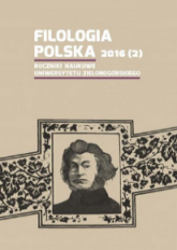Conceptualization of senses in Mickiewicz’s output
Keywords
Abstract
Linguists can reconstruct a conceptualization of senses in Adam Mickiewicz’s writings on the basis of the writer’s language dictionary. Lexicon characterizing each sense were arranged in semantic categories connected with one another, which construct a frame semantic. The writer was susceptible to each of senses but most often he referred to sight and hearing. Mickiewicz used a complete variety of words specific to his epoch. Adam Mickiewicz didn’t form new words in the studied range of vocabulary.
References
LITERATURA CYTOWANA
Fillmore C. J., 1982, Frame Semantics, [w:] Linguistics in the Morning Calm, red. The Linguistics Society of Korea, Seoul, s. 111-137.
[Google Scholar]
Fillmore C. J., 1985, Frames and the semantics of understanding, “Quaderni di Semantica”, Vol. 6.2, s. 222-254.
[Google Scholar]
Fillmore C. J., Atkins Beryl T., 1992, Towards a Frame-Based Lexocon:The Semantics of RISK and its Neighbors, [w:] Frames, Fields and Contrasts. New Essays in Semantic and Lexical Organization, eds. A. Lehrer E., Kittay F., New Jersey, s. 76-101.
[Google Scholar]
Guiraud P., Les caractéres statistiques du vocabulaire, Paris 1954.
[Google Scholar]
Johnson C. R., Petruck Miriam R. L., Baker Collin F., Ellsworth Michael, Ruppenhofer Josef, Fillmore Charles, 2003, FrameNet: Theory and Practice. Version 1.1, wersja elektroniczna dostęna 13.03.2015: [book.pdf].
[Google Scholar]
Judycka I., 1963, Synestezja w rozwoju znaczeniowym wyrazów, „Prace Filologiczne” 18, s. 59-78.
[Google Scholar]
Kładoczny P., 2012, Semantyka nazw dźwięków w języku polskim, t. 1-2, Oficyna Wydawnicza Leksem, Łask.
[Google Scholar]
Kładoczny P., 2014, Rama interpretacyjna percepcji słuchowej, w: Narracyjność języka i kultury, red. Dorota Filar, Dorota Piekarczyk, Wydawnictwo UMCS, Lublin, s. 161-177.
[Google Scholar]
Kubicka A., Poetyckie konkretyzacje zmysłów w wierszach Cypriana Norwida, Warszawa 2013, s. 8 [rozprawa doktorska Wydziału Filologii Polskiej, dostępna pod adresem: [Anna%20Kubicka%20-%20Zmys%C5%82y%20u%20Norwida.pdf] dostęp: 4.04.2016).
[Google Scholar]
Linde-Usiekniewicz J., 2010, Od przypadków głębokich do elementów ram we FrameNecie, [w:] Ramki: rygorystyczna aplikacja metodologii kognitywno-interpretacyjnej, red. Magdalena Zawisławska, Elipsa, Warszawa, s. 17-52.
[Google Scholar]
Nęcka E., Orzechowski J., Szymura B., 2008, Psychologia poznawcza, PWN, Academica Wydawnictwo SWPS, Warszawa.
[Google Scholar]
Praz M., Zmysły, śmierć i diabeł w literaturze romantycznej, tł. Krzysztof Żaboklicki, Warszawa 1974.
[Google Scholar]
Ramki: rygorystyczna aplikacja metodologii kognitywno-interpretacyjnej, red. Magdalena Zawisławska, Elipsa, Warszawa, 2010.
[Google Scholar]
Rudnicka-Fira E., Słownictwo „Dziadów” Adama Mickiewicza w świetle analizy statystycznej, Katowice 1986.
[Google Scholar]
Ruppenhofer Josef, Ellsworth Michael, Petruck Miriam R. L., Johnson Christopher R., Scheffczyk J., 2010, FrameNet II: Extended Theory and Practice, wersja elektroniczna dostęna 13.03.2015: [book.pdf].
[Google Scholar]
Sambor J., Badanie statystyczne nad słownictwem (na materiale „Pana Tadeusza”), Wrocław 1969.
[Google Scholar]
Słownik języka Adama Mickiewicza, red. Konrad Górski, Stanisław Hrabec, t. 1-11, Ossolineum, Wrocław 1962-1983.
[Google Scholar]
Stachurski E., Słowa-klucze polskiej epiki romantycznej, Kraków 1998.
[Google Scholar]
Woronow I., Romantyczna idea korespondencji sztuk. Standal, Hoffman, Boudelaire, Norwid, Kraków 2008.
[Google Scholar]
Wyka K., Słowa-klucze, [w:] Zagadnieniach rodzajów literackich, t. IV, z. 2 (7), red. Stefania Skwarczyńska, Jan Trzynadlowski, Witold Ostrowski, Łódź 1962, s. 5-34.
[Google Scholar]
Zawisławska M., Czasowniki oznaczające percepcję wzrokową we współczesnej polszczyźnie. Ujęcie kognitywne, Wydział Polonistyki Uniwersytetu Warszawskiego, Warszawa 2004.
[Google Scholar]
Zawisławska M., Ramy interpretacyjne jako narzędzie opisu znaczenia, [w:] Ramki: rygorystyczna aplikacja metodologii kognitywno-interpretacyjnej, red. Magdalena Zawisławska, Elipsa, Warszawa 2010, s. 53-73.
[Google Scholar]
Preview
Downloads
Published
How to Cite
Issue
Section
Categories
Copyright & License

This work is licensed under a Creative Commons Attribution-NonCommercial-NoDerivatives 4.0 International License.
Copyrights (a). In principle, authors who are not employed by the University of Zielona Góra retain the copyright, including publishing rights to the articles, without restrictions.
Copyrights (b). In principle, authors who are employed by the University of Zielona Góra, do not retain the copyright, including publishing rights to the articles. In such cases the copyright holder is the University of Zielona Góra.
Print ISSN
2450-3584-
Abstract135











































